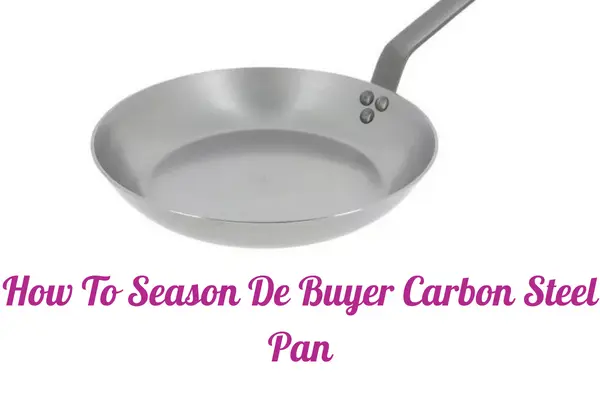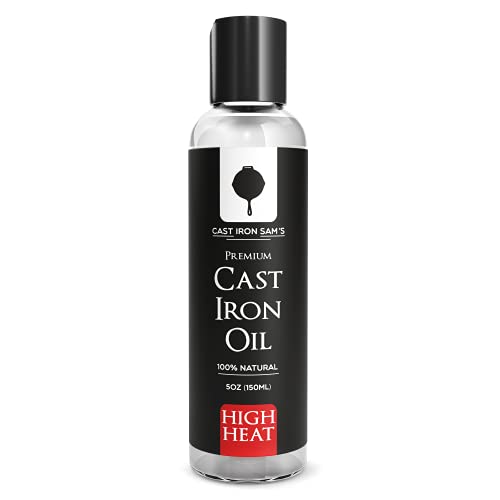Ever tried to season your De Buyer carbon steel pan, and it came out nasty sticky? The thick film of oil film was quite disappointing. The multiple layers, everything sticking, and ripping off can make you go nuts!
The fact is, you need true, detailed, and tested De Buyer seasoning instructions. Your pan will come out perfectly seasoned, and you will no longer experience the multiple layers and sticky situations. Above all, the right seasoning gives you a lifetime nonstick carbon steel pan.
Here are the steps to seasoning your De Buyer carbon steel pan!
Seasoning Your De Buyer Carbon Steel Pan
Before we get into the process;
What Is Seasoning A Pan?
The process involves creating epoxide layers all over your carbon steel cookware. And the purpose is to make your pan nonstick and free from rust.
When you first buy a carbon steel pan, it comes with a protective layer, but this should not fool you. It will not last and is vulnerable to rust because it does not have a protective coating.
It is all messy cooking as your ingredients keep sticking and ripping off. But you can take it through the seasoning process to create a film that prevents rusting and sticking. That way, your pan will last longer and help you achieve many delicious dishes.
And although the process may look outdated because of the many nonstick pans available in the market, it remains the safest.
Nonstick coating materials like Teflon are dangerous when you expose them to heat. Research shows that Teflon has carcinogenic emissions when you expose it to heat.
Besides, the coating peels off over time, leaving your pan ugly and unhygienic to use. The only solution with a charred Teflon pan is to remove all the coat and season it like a carbon steel wok.
Seasoning a pan means heating it to convert thin layers of oil into multiple solid polymer protective coatings. These multiple coats bind to the surface of your pan and make it nonstick.
The best oils to use are grapeseed, canola, and vegetable oil. Olive oil, shortening, lard, or butter will leave your pan with sediments. Flaxseed will peel off after some time.
How To Season A De Buyer Carbon Steel Pan;
Here are the steps to making your new De Buyer carbon steel pan nonstick;
Step One: Remove The Protective Coating
Although most carbon steel pans are unseasoned, they have a protective layer that prevents rusting. The unseasoned pan is metallic grey. According to the manufacturer’s guidelines for various materials, you have to remove the top layer.
Once you peel off the layer, clean your pan thoroughly to ensure that no residues remain on the surface. Give your pan a quick wipe using a paper towel. Keeping your pan wet for a longer time will attract rust faster than you think.
Step 2: Drying The Pan Over A Stove
Step two above, you dried your pan with a towel, but you need to make that thorough by setting it over a hot stove to dry off extra moisture.
Step 3: Apply Oil
Reach out for canola oil, grapeseed, or vegetable oil and apply the first layer of fat, which is also the first layer of the seasoning.
Step 4: Re-heat
This step involves heating your pan in an oven or over a burner.
But before you do that, check out if your carbon steel panhandle is oven safe so that you heat your cookware in an oven. You don’t have to research as the details on whether to use the handle in an oven or not are right there in your pan’s user manual.
Step 5: Re-apply Oil
Get a few drops of oil and apply them on a kitchen towel. Rub the towel on your carbon steel wok. That’s the second layer of seasoning.
Buff the oil away until the pan looks slightly dry. Here is where many hands go wrong. They rub excess oil, which messes up with the process.
When I first seasoned my carbon steel pan, I messed up at this stage, and all I got was a sticky and splotchy coating which was very difficult to clean.
Step 6: Burn Your Pan
First, ensure no traces of oil on your pan and then put it in the oven at 450 degrees Fahrenheit to burn. I can guarantee that if you do it right at this stage, you will give your pan a lifelong seasoning.
Burn your pan from metallic gray to a brown color. At first, it will be a smoldering smoke that eventually fades away, leaving your pan with a brownish coating.
If your pan’s handle is not oven-safe, you will use the stovetop to burn it, not damage the parts. Move the pan around the burner for the heat to evenly distribute all over the pan.
Seasoning is thirty minutes process that forms a polymer evenly. The faint shade of brown that you see is called seasoning. And the darker the color, the more nonstick it becomes.
De Buyer Seasoning Instructions
De Buyer carbon steel pans are not difficult to season. They come with a removable beeswax coating that you can peel off with hot water and a cloth or sponge. Have a look at the seasoning instructions;
- The first step would be to peel off the beeswax coating.
Boil water separately and pour it in a large basin (larger enough for your pan to fit). - Reach out for canola, vegetable, or grapeseed oil and apply it to a clean cloth.
- Rub the oil on the pan on both sides, and be sure to wipe until the pan is dry. Don’t worry; there will still be oil left on your pan.
Place your pan in an oven (450 degrees Fahrenheit) or over a burner if you fear that the handle is not oven safe. - On the burner, you will keep moving the pan around to have a uniform heat distribution.
- Your pan will begin smoking. Don’t panic, as this is part of the process. After a few minutes (about 30 or 10 minutes in the oven or the burner, respectively), your pan will turn light brown. That’s the epoxide forming. And the darker the color, the better the pan.
- Season your pan regularly to build up the seasoning. When cleaning, use the chainmail not to destroy the seasoning. The scrubber helps to build the layers.
At A Glance!
Can You Season De Buyer In The Oven?
De buyer pans have different material compositions. The pan is usually made of steel carbon, but the handles have a different material. They can be silicone, wooden, or even metallic. You will also find coated handles.
What is the handle material before you think of seasoning your pan in an oven? Some materials are not oven-safe. The De Buyer has different users’ manuals for specific pans.
Read through your manual to understand the dos and don’ts for your pan. If the handle is oven-safe, you can go ahead and burn your pan in the oven. Use a burner to season your De Buyer pan for the oven-sensitive handles.
As you burn your cookware, ensure that you move the pan around the flames so that the heat reaches all the edges. For the base and inside the pan, those are safe in the oven and over a burner.
You May Also Like:
- The 5 Best Spatula For Carbon Steel Pan
- The 5 Best Baking Pan For Air Fryer
- Is A Skillet A Frying Pan?
Conclusion
Seasoning your De Buyer pan will give you nonstick cookware safe from rust, toxins, and sediments. It will never peel off and will give you the best outcome. You have to follow the instructions; otherwise, your work will turn out grimy and messy.
The right seasoning procedure turns your pan into durable and reliable cookware. You enjoy tossing your veggies, scrambling your eggs, cooking omelets, shallow frying your fish, and even stir-frying your meat without sticking on the base of your pan.





